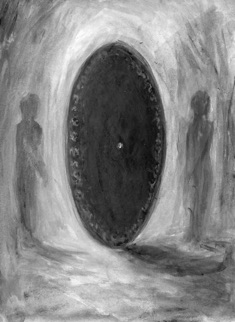The Panorama in History

The first 360 degrees panorama was developed around 1790 by the English artist Robert Baker (1739-1806). Robert Baker is the inventor of the classic panorama. He conceived of the painting without boundaries, the painting that could not be seen in its entirety in one look. In a sense, it has much in common with dome paintings in churches. The famous Spanish painter Goya made his unequalled dome painting Miracle of St. Anthony of Padua in the San Antonio de la Florida chapel in Madrid. Here too the viewer cannot see all of the painted image in one glance. Our eyes explore the space and navigate through it in order to view all the aspects of the painting and to find out how the painted figures relate to each other.
Robert Baker developed “rules” which a painted panorama, and its presentation, should obey. A painted panorama completes a full circle and neither the top nor the bottom of the canvas are visible to the viewer. The panorama is placed in a circular building and the visitor enters, from a dark space, via a spiral staircase that ends in the centre of the panorama. The panorama itself is displayed in daylight. A glass dome at the roof of the building – which is shielded from view by a “velum” so the viewer has no contact with the outside world – sheds indirect light on the painting. In front of the canvas a so-called “faux terrain” is laid out, with objects and figures. This terrain strongly enhances the optical illusion as well as the perspective. It also hides the bottom of the painting from view. The spectator finds himself in the center of the panorama, surrounded by the painting and closed off from the exterior world.
Painted panoramas characteristically portrayed reality as accurately as possible. Photography and film ha, after all, not yet been invented. Displays consisted of city views, such as the view of Edinburgh, the panorama of Constantinople, or the famous canvas depicting Cairo and the borders of the Nile. Occasionally, panoramas were painted that depicted religious themes, but war and battle scenes were much more popular subjects. The Siege of Paris by Henry Felix Emmanuel Philippoteaux, the Battle at Sedan, the Bourbaki panorama in Luzern, the Battle at Waterloo. Artists would visit the area immediately after the battle had ended and from personal observation and interviews with those involved they painted a picture of the slaughter as accurately as possible. Panoramas were traveling attractions and they drew large crowds. Hundreds were painted in the 19th century, but with the advent of cinematography interest for the painted panoramas declined. After all, the camera recorded reality much quicker and even more straightforward.
The majority of panoramas has been lost. Today, only some 20 survive in their original form. One of these is the Panorama Mesdag in The Hague (Netherlands), named after the painter Hendrik Willem Mesdag. Commissioned by a Belgian panorama company, Mesdag painted a panorama of the small bathing and fishing town called Scheveningen, near The Hague, and not far from his home.
During the 20th century very few new panoramas were painted. In 1986 a new one opened in Al-Mada, Iraq. It depicts the historical battle of Al-Quaddisyah, that took place in 637: Arabs on horseback against the Persian army on elephants. Most likely, this panorama symbolises the more recent war between Iraq and Iran. Recently, new painted panoramas were opened in Jinzhou and Dandong, China.
Almost concurrent with the development of the OMNIMAX/IMAX Dome theatres, experiments with moving images in a panorama format start with the advent of the video camera. Artists start experimenting with spatial constellations of monitors and projectors. The American artist Ira Schneider is one of the first to place monitors in a circle. His installation Time Zones shows the 24 time zones of the world by using 24 monitors placed in a circle in a dark space. 24 recordings of the same half hour were made at 24 locations around the world. These recordings are played simultaneously in the video panorama. Spectators see the sun rise and when they turn around, they see it going down. Light and dark. As with the painted panoramas, Schneider shows reality but the subject is much wider in scope. And just like the artists who painted panoramas, Schneider worked with a group of assistants, some of them well-known artists in their own right. Bill Viola and Juan Downey, for instance, made some of the video recordings that can be seen in Schneider’s panorama. A new generation of artists is quick to abandon the representation of reality and starts to manipulate image, time, and space. Marie-Jo Lafontaine (B) made several installations in circular format: A la cinco de la tarde (1985) Victoria (1988) en Chill Out (1999), George Snow's ‘Motorway’ (1997) was one of the first panorama installations working with video projection, Gary Hill's (USA) ‘Beacon (Two Versions of the Imaginary)’ (1990) which uses 2 monitors as projection source mounted in a cylinder which project images from both ends, Jeffrey Shaw's (AUS) interactive installation ‘The Legible City’ (1989) , Jeffrey Shaw a pioneer in interactive applications created together with Neil Brown, Dennis Del Favero and Peter Weibel ‘T Visionarium’ ( 2008). ‘T Visionarium’ offers the means to capture and re-present televisual information, allowing viewers to explore and actively edit a multitude of stories in three dimensions. Andre Parente (BR) created ‘Visorama-NBP’ (2002), Kurt d’Haeseleer (B) made Scripted Emotions (2007) an interactive panoramic installation which is to be experienced through two sets of touristic binoculars and recently Giny Vos (NL) created an immersive installation ‘Round and Round’ (2011). They all develop new forms of panoramas, their common characteristic being that the viewer is surrounded by image, and often sound, in a 360 degrees environment. The viewer searches space, explores space and discovers varying images that are coherent, but cannot be seen all at once.
The 360º Degree Panorama
-from still to moving image
